harmony 鸿蒙textPath
textPath
The <textPath> component is used to draw text along the path.
NOTE - This component is supported since API version 7. Updates will be marked with a superscript to indicate their earliest API version.
This component can have <tspan> components nested for segmenting.
This component can only be nested in the <text> component.
Required Permissions
None
Child Components
The <tspan> child component is supported.
Attributes
The attributes in the following table are supported.
| Name | Type | Default Value | Description |
|---|---|---|---|
| id | string | - | Unique ID of the component. |
| path | string | 0 | Shape of the path. The meanings of the letters are as follows: - M = moveto - L = lineto - H = horizontal lineto - V = vertical lineto - C = curveto - S = smooth curveto - Q = quadratic Belzier curve - T = smooth quadratic Belzier curveto - A = elliptical Arc - Z = closepath Default value: 0 |
| startOffset | <length>|<percentage> | 0 | Offset of the text start point relative to the path start point. Default value: 0 |
| font-size | <length> | 30px | Font size. Default value: 30px |
| fill | <color> | black | Font fill color. Default value: black |
| by | number | - | Attribute offset relative to the specified animation. By default, from is the original attribute value. |
| opacity | number | 1 | Opacity of an element. The value ranges from 0 to 1. The value 1 means opaque, and 0 means completely transparent. Attribute animations are supported. Default value: 0 |
| fill-opacity | number | 1.0 | Font fill opacity. Default value: 1.0 |
| stroke | <color> | black | Stroke color. Default value: black |
| stroke-width | number | 1px | Stroke width. Default value: 1px |
| stroke-opacity | number | 1.0 | Stroke opacity. Default value: 1.0 |
Example
The following is an example of the <textspan> attributes, where text is drawn along the path specified by path, and the start point is offset by 20% of the path length. (The drawn <path> curve is for reference only.)
<!-- xxx.hml -->
<div class="container">
<svg fill="#00FF00" x="50">
<path d="M40,360 Q360,360 360,180 Q360,40 200,40 Q40,40 40,160 Q40,280 180,280 Q280,280 300,200" stroke="red" fill="none"></path>
<text>
<textpath fill="blue" startOffset="20%" path="M40,360 Q360,360 360,180 Q360,40 200,40 Q40,40 40,160 Q40,280 180,280 Q280,280 300,200" font-size="30px">
This is textpath test.
</textpath>
</text>
</svg>
</div>
/* xxx.css */
.container {
flex-direction: row;
justify-content: flex-start;
align-items: flex-start;
height: 1200px;
width: 600px;
}
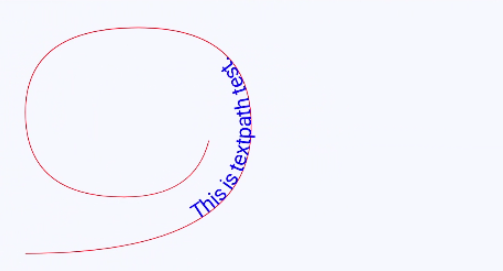
Combination of <textpath> and <tspan>
<!-- xxx.hml -->
<div class="container">
<svg fill="#00FF00" x="50">
<path d="M40,360 Q360,360 360,180 Q360,40 200,40 Q40,40 40,160 Q40,280 180,280 Q280,280 300,200" stroke="red" fill="none"></path>
<text>
<textpath fill="blue" startOffset="20%" path="M40,360 Q360,360 360,180 Q360,40 200,40 Q40,40 40,160 Q40,280 180,280 Q280,280 300,200" font-size="15px">
<tspan dx="-50px" fill="red">This is tspan onTextPath.</tspan>
<tspan font-size="25px">Let's play.</tspan>
<tspan font-size="30px" fill="#00FF00">12345678912354567891234567891234567891234567891234567890</tspan>
</textpath>
</text>
</svg>
</div>
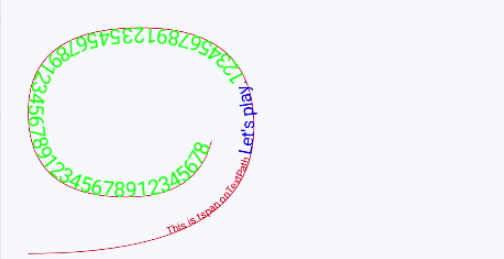
<!-- xxx.hml -->
<div class="container">
<svg fill="#00FF00" x="50">
<path d="M40,360 Q360,360 360,180 Q360,40 200,40 Q40,40 40,160 Q40,280 180,280 Q280,280 300,200" stroke="red" fill="none"></path>
<text>
<textpath fill="#D2691E" path="M40,360 Q360,360 360,180 Q360,40 200,40 Q40,40 40,160 Q40,280 180,280 Q280,280 300,200" font-size="30px" stroke="black" stroke-width="1" >
This is TextPath.
<tspan font-size="20px" fill="red">This is tspan onTextPath.</tspan>
<tspan font-size="30px">Let's play.</tspan>
<tspan font-size="40px" fill="#00FF00" stroke="blue" stroke-width="2">12345678912354567891234567891234567891234567891234567890
</tspan>
</textpath>
</text>
</svg>
</div>
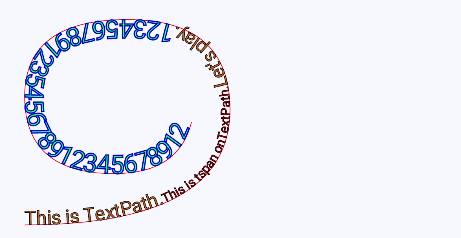
<!-- xxx.hml -->
<div class="container">
<svg fill="#00FF00" x="50">
<path d="M40,360 Q360,360 360,180 Q360,40 200,40 Q40,40 40,160 Q40,280 180,280 Q280,280 300,200" stroke="red" fill="none">
</path>
<!-- Value percentage -->
<text>
<textpath fill="#D2691E" path="M40,360 Q360,360 360,180 Q360,40 200,40 Q40,40 40,160 Q40,280 180,280 Q280,280 300,200" font-size="30px">
This is TextPath.
<tspan x="50" fill="blue">This is first tspan.</tspan>
<tspan x="50%">This is second tspan.</tspan>
<tspan dx="10%">12345678912354567891234567891234567891234567891234567890</tspan>
</textpath>
</text>
</svg>
</div>
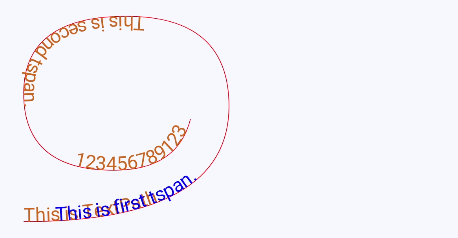
The following is an example of the startOffset animation, where the value of startOffset changes from 10% to 40%, and the text is not drawn when its length exceeds the path length range.
/* xxx.css */
.container {
flex-direction: row;
justify-content: flex-start;
align-items: flex-start;
height: 3000px;
width: 1080px;
}
<!-- xxx.hml -->
<div class="container">
<svg fill="#00FF00">
<path d="M40,360 Q360,360 360,180 Q360,40 200,40 Q40,40 40,160 Q40,280 180,280 Q280,280 300,200" stroke="red" fill="none"></path>
<text>
<textpath fill="blue" startOffset="10%" path="M40,360 Q360,360 360,180 Q360,40 200,40 Q40,40 40,160 Q40,280 180,280 Q280,280 300,200" font-size="15px">
<tspan dx="-50px" fill="red">This is tspan onTextPath.</tspan>
<tspan font-size="25px">Let's play.</tspan>
<tspan font-size="30px" fill="#00FF00">12345678912354567891234567891234567891234567891234567890</tspan>
<animate attributeName="startOffset" from="10%" to="40%" dur="3s" repeatCount="indefinite"></animate>
</textpath>
</text>
</svg>
</div>
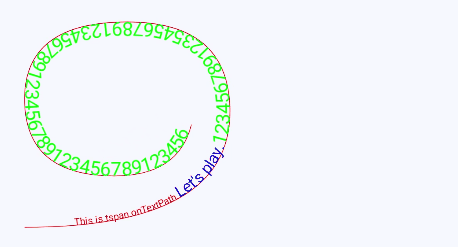
Attribute animation of the <textPath> and <tspan> in combination
<!-- xxx.hml -->
<div class="container">
<svg fill="#00FF00">
<path d="M40,360 Q360,360 360,180 Q360,40 200,40 Q40,40 40,160 Q40,280 180,280 Q280,280 300,200" stroke="red" fill="none">
</path>
<text>
<textpath fill="#D2691E" path="M40,360 Q360,360 360,180 Q360,40 200,40 Q40,40 40,160 Q40,280 180,280 Q280,280 300,200" font-size="30px">
This is TextPath.
<tspan x="50" fill="blue">
tspan attribute x|rotate
<animate attributeName="x" from="50" to="100" dur="5s" repeatCount="indefinite"></animate>
<animate attributeName="rotate" from="0" to="360" dur="5s" repeatCount="indefinite"></animate>
</tspan>
<tspan x="30%">tspan static.</tspan>
<tspan>
tspan attribute dx|opacity
<animate attributeName="dx" from="0%" to="30%" dur="3s" repeatCount="indefinite"></animate>
<animate attributeName="opacity" from="0.01" to="0.99" dur="3s" repeatCount="indefinite"></animate>
</tspan>
<tspan dx="5%">tspan move</tspan>
</textpath>
</text>
</svg>
</div>
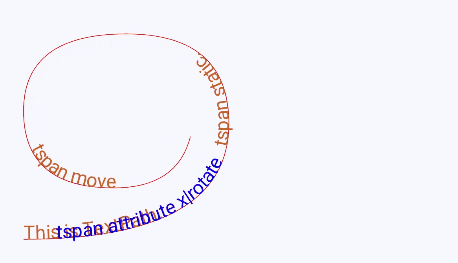
(1) “tspan attribute x|rotate”: The beginning of the text is offset from 50 px to 100 px, and the text rotates clockwise by 0 degrees to 360 degrees.
(2) “tspan attribute dx|opacity”: The text is drawn after the “tspan static.” drawing is complete. The horizontal offset moves from 0% to 30%, and the opacity changes from shallow to deep.
(3) tspan move: After the previous <tspan> is drawn, the next <tspan> is drawn with an offset of 5%, creating the effect of following the previous <tspan>.
Attribute animation of the <textPath> and <tspan> in combination
<!-- xxx.hml -->
<div class="container">
<svg fill="#00FF00">
<path d="M40,360 Q360,360 360,180 Q360,40 200,40 Q40,40 40,160 Q40,280 180,280 Q280,280 300,200" stroke="red"
fill="none">
</path>
<text>
<textpath fill="#D2691E" path="M40,360 Q360,360 360,180 Q360,40 200,40 Q40,40 40,160 Q40,280 180,280 Q280,280 300,200" font-size="30px">
This is TextPath.
<tspan dx="20" fill="blue">
tspan attribute fill|fill-opacity
<animate attributeName="fill" from="blue" to="red" dur="3s" repeatCount="indefinite"></animate>
<animate attributeName="fill-opacity" from="0.01" to="0.99" dur="3s" repeatCount="indefinite"></animate>
</tspan>
<tspan dx="20" fill="blue">
tspan attribute font-size
<animate attributeName="font-size" from="10" to="50" dur="3s" repeatCount="indefinite"></animate>
</tspan>
</textpath>
<tspan font-size="30">Single tspan</tspan>
</text>
</svg>
</div>
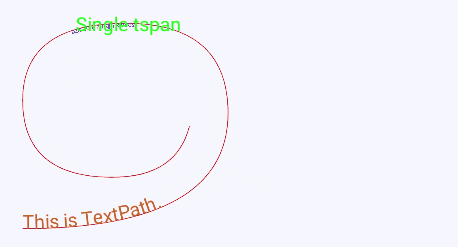
(1) “This is TextPath.”: The first segment of text, in the size of 30px and color of #D2691E is drawn on the path without offset.
(2) “tspan attribute fill|fill-opacity”: The new segment of text is 20px offset from the end of the previous text segment. The text color changes from blue to red, and the opacity changes from light to deep.
(3) “tspan attribute font-size”: The new segment of text is 20px offset from the end of the previous text segment. While the start point of the text is static, the font size shifts from 10px to 50px and the overall length is continuously prolonged.
(4) “Single tspan”: A horizontal line is drawn at the end of the previous segment, creating the effect of following the previous segment.
Attribute animation of the <textPath> and <tspan> in combination
<!-- xxx.hml -->
<div class="container">
<svg fill="#00FF00">
<path d="M40,360 Q360,360 360,180 Q360,40 200,40 Q40,40 40,160 Q40,280 180,280 Q280,280 300,200" stroke="red"
fill="none">
</path>
<text>
<textpath fill="#D2691E" path="M40,360 Q360,360 360,180 Q360,40 200,40 Q40,40 40,160 Q40,280 180,280 Q280,280 300,200" font-size="30px">
This is TextPath.
<tspan dx="20" fill="blue">
tspan attribute stroke
<animate attributeName="stroke" from="red" to="#00FF00" dur="3s" repeatCount="indefinite"></animate>
</tspan>
<tspan dx="20" fill="white" stroke="red">
tspan attribute stroke-width-opacity
<animate attributeName="stroke-width" from="1" to="5" dur="3s" repeatCount="indefinite"></animate>
<animate attributeName="stroke-opacity" from="0.01" to="0.99" dur="3s" repeatCount="indefinite"></animate>
</tspan>
</textpath>
</text>
</svg>
</div>

(1) “tspan attribute stroke”: The stroke color gradually changes from red to green.
(2) “tspan attribute stroke-width-opacity”: The stroke width changes from 1px to 5px, and the opacity changes from shallow to deep.
你可能感兴趣的鸿蒙文章
harmony 鸿蒙JavaScript-compatible Web-like Development Paradigm
- 所属分类: 后端技术
- 本文标签:
热门推荐
-
2、 - 优质文章
-
3、 gate.io
-
8、 golang
-
9、 openharmony
-
10、 Vue中input框自动聚焦